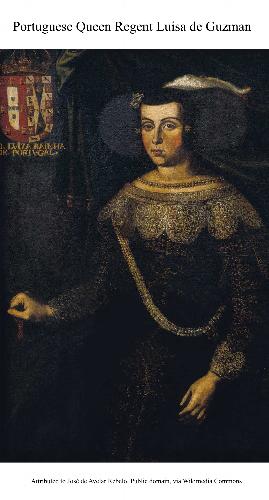In 1661 Luisa de Guzman was in desperate need.
 Queen Regent of Portugal since the death of her husband – King John IV, Duke of Braganza - she was ruling on behalf of her son who was still a minor. Twenty years earlier her husband's coup had sought to end Portugal's subservience to the ‘joint monarchy' of Spain and Portugal.
Queen Regent of Portugal since the death of her husband – King John IV, Duke of Braganza - she was ruling on behalf of her son who was still a minor. Twenty years earlier her husband's coup had sought to end Portugal's subservience to the ‘joint monarchy' of Spain and Portugal.
Since then Portugal had managed a precarious twilight independence with frequent cross-border raids and occasional battles.
Initially Portugal had benefited from Spain's preoccupation with its wars against France and the United Provinces. In 1648 the Dutch had signed a treaty with France and despite agreeing a European non-aggression treaty with Portugal had continued attacking Portuguese overseas territories. Then in 1659 France had also abandoned Portugal. In return for territorial gains offered by Philip IV of Spain, Louis XIV had recognised him as ruler of Portugal in the Treaty of the Pyrenees.
Now Spain was poised to give its full attention to crushing the Portuguese rebellion.
Portugal was in dire need of a new ally.
At first glance it would appear Charles' restoration to the English throne would place Spain in an even stronger position. The Spanish had, after all, supported Charles during his enforced exile years. Royalist Regiments led by James Duke of York had fought alongside Spain in Flanders on the promise that victory would lead to a Spanish invasion of England to restore Charles to the throne. That victory had been denied by the Cromwellian navy blockading Dunkirk and the New Model Army fighting for France, but still Spain was the only country to have provided succour and hope to Charles.
On the other hand, Portugal had traditionally been a good ally to the English monarchy. Elizabeth had sent the English Armada to support the failed rebellion of 1589, and Portugal had given safe haven to Prince Rupert's Royalist ships when pursued by Blake with Cromwell's navy during the English inter-regnum.
Charles' restoration might provide a life-line for the Queen Regent – but how could she negotiate an alliance?
Alliances were usually sealed by uniting the two ruling houses with a marriage. Charles was still single and in need of a wife to produce an heir and secure his line. Luisa de Gusman's daughter with King John IV was Catherine of Braganza.
 She was, of course, a Royal Princess and, having been brought up in a convent, her chastity was beyond doubt. Luisa's court artist Dirk Stoop would be well able to paint a flattering portrait of Catherine which would appeal to the English King's sensual nature.
She was, of course, a Royal Princess and, having been brought up in a convent, her chastity was beyond doubt. Luisa's court artist Dirk Stoop would be well able to paint a flattering portrait of Catherine which would appeal to the English King's sensual nature.
But Portugal was not militarily strong, and her navy was not what is used to be, so a substantial dowry would be needed to convince Charles' advisers to accept Luisa's proposal.
Some of Portugal's foreign possessions were more of a drain on her resources than they were worth and England was looking to expand its overseas interests - Cromwell had tried to take Hispaniola from the Spanish - and the English navy seemed to be growing by the day.
Bombay was a liability to Portugal, but the English might see it as a useful base for their East India Company.
Portuguese Fort in Bombay
(nichalp via wikicommons)
Tangier was expensive to maintain – it would be emotionally difficult for the Portuguese to leave the African city after so many years and all the blood spilled; but the truth was it was producing nothing and Portugal would be better off with it safely in English hands than taken over by the Spanish or the Ottomans.
Queen Regent Luisa might also offer England free trade with the South American colonies – a costly concession, but that could be counter-balanced by an English promise to raise and equip veterans of their fanatical New Model Army troops to fight with Portugal against Spain. All of these offerings would benefit Portugal as much as England, and some financial incentive could be added as necessary.
Luisa sent offers via Dom Francisco de Mello the Portuguese Ambassador in London. Initially Charles was in favour of the match, but Spain objected and offered to support virtually any other country's proposal and things began to look uncertain. Eventually in March 1661 Louis XIV sent a special envoy to support the Portuguese offer, in May Charles announced his proposed marriage and in July he appointed Edward Montague, by now Earl of Sandwich, extraordinary Ambassador to Portugal and sent letters to Luisa confirming his acceptance of the terms.
As it happened quite a large sum was required to seal the deal, but what was paid was largely in kind rather than in gold, and truth to tell, as with many dowries at the time, much of it was never paid. at all.
Luisa had skillfully managed to off-load Tangier - a city that had caused the Portuguese great heart-ache as well as considerable military resources it could ill-afford at the same time as ensuring the Spanish did not get the benefit of English aid, as well as obtaining – in due course – 3,000 extremely valuable English mercenaries to join the Portuguese army.
Fact Check:
Most of the information in this article comes from
Britannica online and
the English Calendar of State Papers and the Records of the Colonial Office held in the National Archives and

